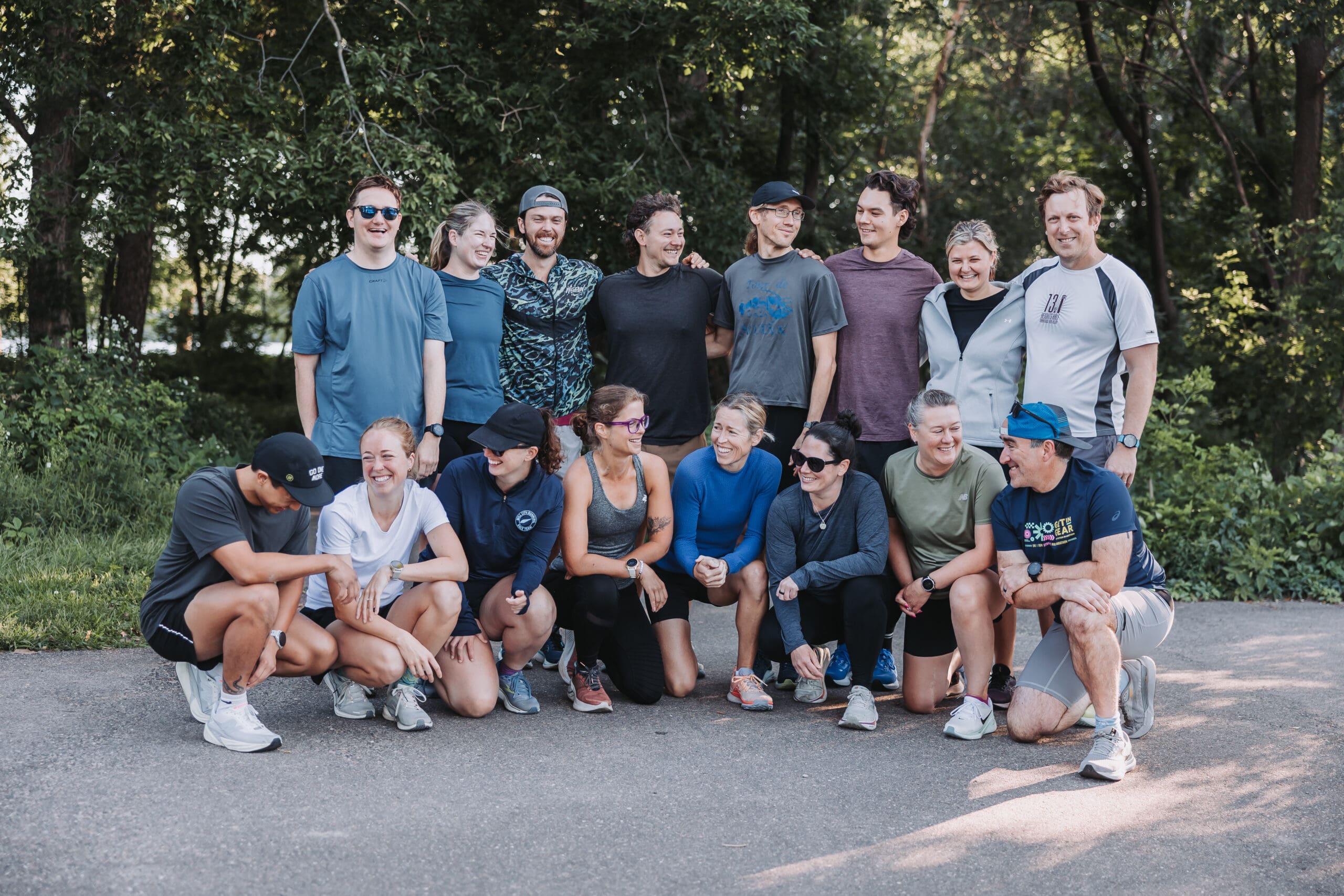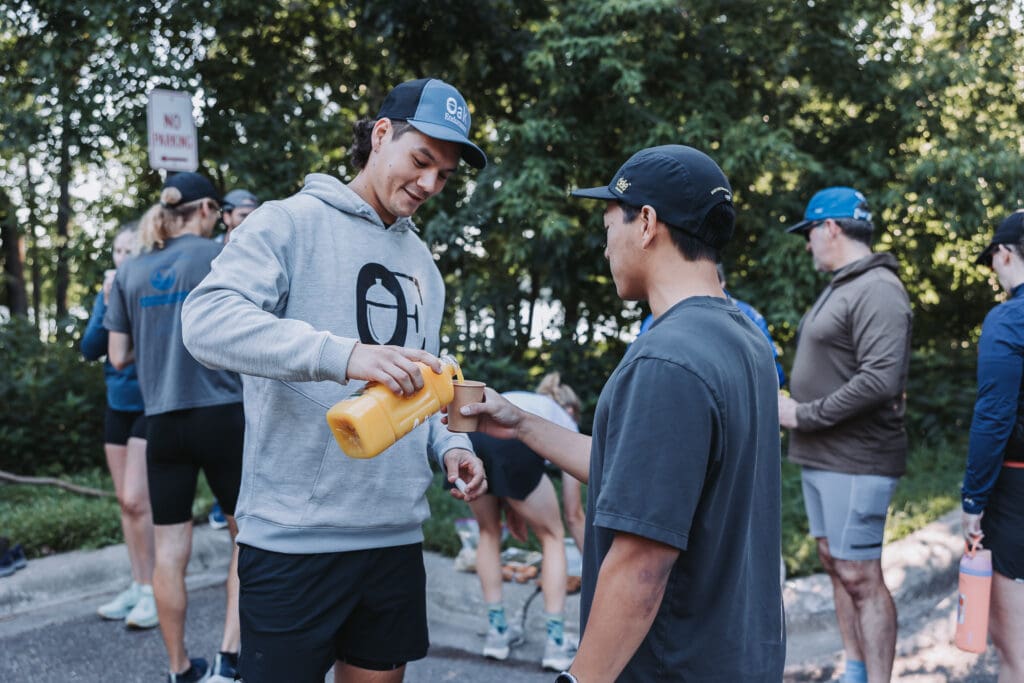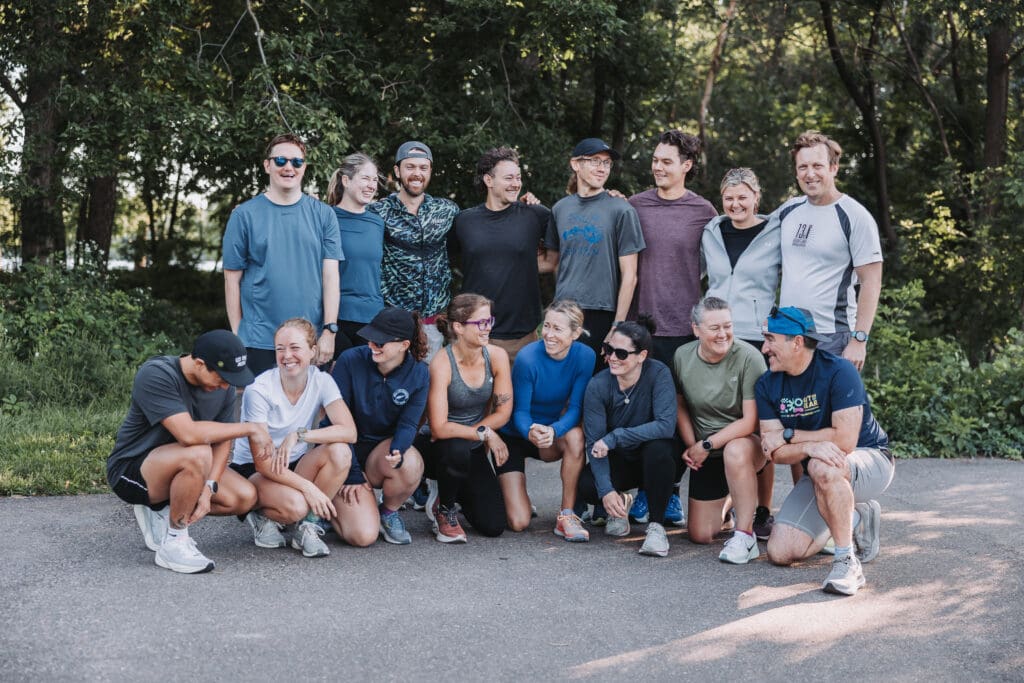
Your Hydration Equation: How Minnesota Runners Can Master Electrolytes Year-Round
November 5, 2025
Date
Category
My first real exposure to electrolytes and the impact they have on our body came during my third marathon on a sunny May day in Minnesota. I ran it with a friend, and at that time we were fully aboard the “water only while running” train. I will admit we also had barely any sugar in our system, which probably played a role in the aftermath and the pain we endured during that race.
We made it to about mile 15 before the cramps started to hit, and by mile 21 we were deep into a run and walk strategy, stopping every few minutes to massage our legs. At that point in my running career, I just thought that was how marathons were supposed to feel. Now, cramping can come from a lot of different things such as lack of strength training, poor fueling, or limited long run prep, but I can tell you with confidence that drinking only water on a hot Minnesota day definitely did not help.
What really opened my eyes was the aftermath. When we crossed the finish line, I looked over and noticed how unwell my friend looked. He felt nauseous and could not even open his hands fully. His stomach was cramping, and his nervous system was clearly struggling to fire the way it should. My aftermath was a little luckier, just sore legs and a brutal recovery, but watching how much it affected him made me realize something deeper was going on.
I needed to learn why…

Before We Start
At Oak Endurance, I coach endurance athletes through strength training for runners, gait work, and recovery strategies designed for injury mitigation and performance. Whether you are part of our Minnesota run coaching community or following along virtually, this guide will help you understand what is happening and what to do about it.
Disclaimer -> Before you continue reading, please know that I am not a medical doctor. The information in this blog is based on my coaching experience and is meant to provide general education and recommendations for athletes I work with. Much of what I share comes from questions I frequently get from clients, and my goal here is to provide a simple guide that anyone can learn from.
This is not meant to be a tailored or individualized program, nor should it replace professional medical advice, diagnosis, or treatment. If you are experiencing persistent or severe pain — especially the kind that does not improve with rest or feels sharp and localized — please consult with a qualified healthcare provider to rule out stress fractures or other medical concerns.
What Are Electrolytes?
Electrolytes are minerals that carry an electrical charge and help your body maintain fluid balance, muscle contraction, and nerve function. They are what keep your body firing efficiently when miles and sweat start to add up.
The Five Electrolytes To Focus On
There are technically eight different electrolytes. I will not be talking about phosphate, bicarbonate, or sulfate here. While they are very important, they are usually regulated internally through diet and not something you need to specifically supplement or focus on for the purposes of this blog.
1. Sodium
Sodium is the main one to think about for endurance athletes. It helps your body retain fluid and supports muscle function and nerve transmission. You lose the most sodium through sweat, especially in humid or hot weather.
When to take it: Before and during long runs or races, especially anything 60 minutes or longer. Most runners need about 400 to 800 milligrams of sodium per hour during workouts or races, though heavy sweaters may need up to 1000 milligrams.
2. Potassium
Potassium helps balance sodium and supports muscle contractions. Low potassium can lead to fatigue or cramps.
When to take it: Include it in your post-run recovery drink or daily hydration for balance.
Found in: Bananas, potatoes, coconut water, and many electrolyte mixes.
3. Magnesium
Magnesium supports over 300 biochemical reactions including muscle relaxation and energy production.
When to take it: Daily or post-run to aid recovery and reduce the risk of cramping.
Found in: Nuts, seeds, leafy greens, or supplements like BPN’s Electrolytes.
4. Calcium
Calcium is not just for bones. It is crucial for muscle contraction and nerve signaling.
When to take it: Regularly through diet from dairy, fortified plant milks, or leafy greens, or included in balanced electrolyte blends.
Found in: Best obtained through food (dairy, fortified milks, leafy greens) rather than supplements unless directed by a doctor.
5. Chloride
Often paired with sodium, chloride helps maintain fluid balance and supports proper digestion.
When to take it: Naturally paired with sodium in most electrolyte products so you do not need to supplement it separately.
Timing: Before, During, and After
Pre-run or race:
Hydrate early with electrolytes. Aim for 16 to 20 ounces of water with electrolytes one to two hours before. This helps you start topped off, especially on humid or long training days.
During:
For runs longer than 60 minutes, aim to replace electrolytes every 30-60 minutes. Use a mix that includes sodium, potassium, and carbohydrates to sustain energy and hydration.
Post-run:
Recovery is not just about protein. Replace lost fluids and electrolytes by rehydrating with a blend that contains sodium and potassium to restore balance.
Get Specific with Your Sweat
Everyone’s sweat rate and sodium concentration are different, which means your needs might not match your training partner’s. If you want to dial it in and understand exactly how much salt your body loses, consider getting a professional sweat test.
Locally, Human Powered Health in Edina and Zion Performance with Zach Zenner both offer sweat testing to help you fine-tune your hydration and fueling strategy. Knowing your numbers can make a big difference in long-distance performance and recovery.
If you are not quite there, I always recommend being mindful of your urine color. The best time to check this is first thing in the morning, but in general, we are looking for a light yellow color. If it is clear, that usually means you have a bit too much water moving through your system. If it is dark yellow, that means you likely need more water and possibly more electrolytes (depending on the situation).
Weather Matters
Humid heat: Sweat loss increases dramatically, which means more sodium loss. Prioritize higher sodium mixes like LMNT.
Dry heat: You may not feel sweaty, but you are still losing fluid. Continue hydrating regularly. You will likely need to take in less sodium. I have actually seen athletes dehydrate themselves by taking too much sodium and not enough water. This is common for someone who goes from a humid climate to a dry climate.
Winter running: Sweat rates drop, but indoor treadmills and layers can still cause dehydration. Do not skip electrolytes just because it is cold.
Coach Jacob’s Go-To Brands
LMNT: My favorite for post-workout replenishment or sauna work. It is high in sodium with 1000 milligrams per packet and sugar-free. You can grab LMNT directly from Dr. Kailee Acu or through me to support small, local business.
Skratch Labs, G.1.M Sport, and Tailwind: My go-to options during workouts and races since they combine electrolytes with carbohydrates for sustained energy.
Other great options: Nuun, BPN Electrolytes, or NutriDyn Dynamic Hydrate are all solid choices for lighter sessions or daily supplementation.
Final Thoughts
As I have mentioned a few times now in this blog, there is more to the picture than just your electrolyte intake, but your electrolyte intake is a crucial piece of a training program and effective race plan. My own training and racing got substantially better after that third marathon when I started implementing proper fueling (full fueling focused blog here on my website) and hydration methods. As always, I recommend working with a professional on this if you have further questions or want specific help. There are some great resources in the area and linked above!
Stay salty, ya’ll!

Blog Post written by Jacob Oak | personal trainer, run coach, and gait analyst that works with endurance athletes through Oak Endurance
close X